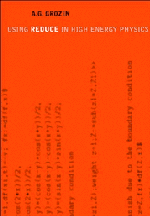Preface
Published online by Cambridge University Press: 20 October 2009
Summary
REDUCE [R1–R10] is a programming language for symbolic calculations with formulae. Usual languages like Fortran, Pascal, or C can only be used for numeric calculations. Several general purpose computer algebra systems are now widely used: Mathematica, Maple, REDUCE, Macsyma, Axiom, MuPAD… Each has its own advantages. As compared with Mathematica, REDUCE has fewer niceties in the user interface and in graphics; but it is as powerful in symbolic calculations, and usually allows one to solve larger problems within given limits of computer resources. REDUCE has long been actively used by many physicists, and a lot of results have been obtained with it. There are many specialized packages written in REDUCE for solving various kinds of problems from diverse branches of physics, which is another good reason for using it. REDUCE is implemented on most classes of computers from PCs and Macs via UNIX workstations and VAXes to supercomputers.
Computer algebra [CA1–CA4] is widely used in physics [CA5, CA6]. Celestial mechanics, general relativity, and high energy physics pioneered this field. For example, computer algebraic methods were widely used in calculations of the electron and muon anomalous magnetic moments, which led to unprecedented accuracy of theoretical predictions confronting equally accurate experiments. Now symbolic calculations are routinely used in all branches of physics. It is essential for every physicist to be able to use a computer not only for number crunching, but also for formula manipulations.
Computer algebra applications vary greatly in scale.
- Type
- Chapter
- Information
- Using REDUCE in High Energy Physics , pp. xi - xivPublisher: Cambridge University PressPrint publication year: 1997



